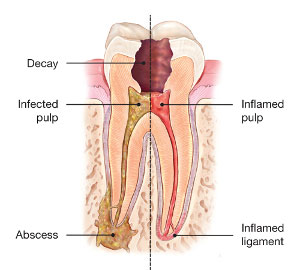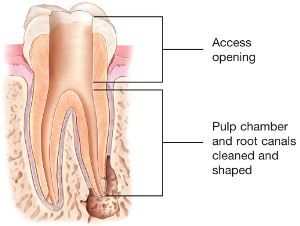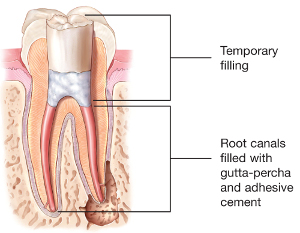Cancel the pain- save the tooth
A endodontics procedure, or root canal, is the typical method for saving a tooth which has developed actual root decay or an abscess. Saving the tooth then involves the rool canal procedure. More than 15 million root canal procedures are performed every year in the U.S. alone. The fact is, root canals can be highly effective in helping you keep your natural tooth despite deep decay or trauma. There’s also a lot of misinformation about how root canals can “fail” or can complicate pain issues. The fact is that a root canal procedure is really no more uncomfortable than having a regular filling and the success rate is approximately 95%. Rarely do root canals “fail”.
What exactly is a root canal?
Many cavities that develop in our teeth can be saved with a typical filling, where the decayed portion of the tooth is removed and a filling material is applied. However, if not addressed in a timely manner, decay can grow into the pulp and root of the tooth where the actual nerves are located. This usually results in a very high level of pain. Other times trama can affect the tooth and cause decay within the root of the tooth, where the tooth nerves are found. When the decay has progressed to this point there are two options – to have the tooth removed thus leaving a gap, or saving the tooth with a root canal procedure.
The procedure
The root canal procedure removes the decay and damaged pulp of the tooth. A special type of filling material is then inserted into the root area, which is then sealed with a temporary crown. The temporary crown is only meant to last untl the permanent crown is created from an impression of the tooth. The crown is usually ready within a couple weeks requiring a trip back to finish the procedure. During this second visit the temporary crown is removed and the permanent crown is applied. The crown is necessary as it provides strength to the tooth so you can chew in a normal fashion and it also adds a costmetic touch to replicate your original tooth structure and whiteness.
Pre and Post Treatment Care
Pre treatment
There’s actually little to prepare for your root canal treatment. The endodontist will have your fill out the required forms including a list of your current medications. You may want to avoid eating for a couple of hours before treatment. Also, depending on the sedation used you may need to arrange for a ride to and from the endodintist’s office.
Post treatment
A root canal procedure usually takes about an hour. After the sedation wears off you may experience some minor discomfort in the general area of the treatment. Depending on the level of discomfort over the counter pain medications are usually suggested, or an ice pack may help provide relief. Depending on the sedative used you can sometimes even return to work later in the day, or you may want to just treat yourself and take the day off.
I’m happy with my experience with Dr. Thomas, had a root canal done on a tooth that was almost not savable and yet he was able to get the job done . Very Nice Doctor, staff and office. Would definitely go there again for any future root canals. Also, No pain during procedure. He did a great job




